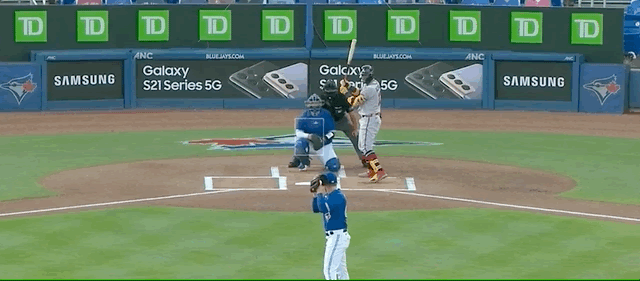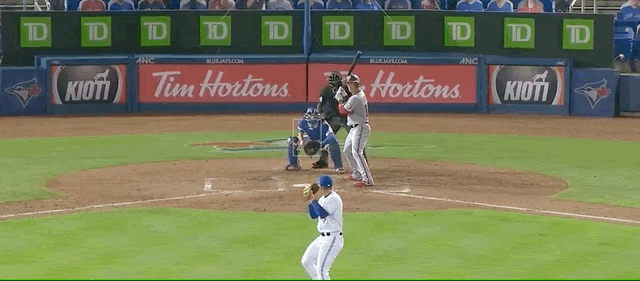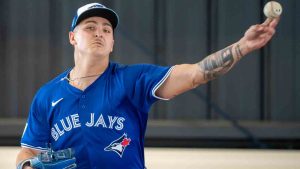At first glance, there isn’t a ton that stands out about Travis Bergen as an MLB pitcher.
The Toronto Blue Jays reliever is the third lefty in a bloated bullpen, he’s got just 34.2 innings under his belt at the major-league level, he doesn’t have a huge arm, and as a former seventh-round pick he doesn’t bring notable prospect pedigree to the table. Although he’s sporting a 0.00 ERA in 6.2 innings this season, no one is projecting him as a bullpen ace.
Bergen seems like yet another under-the-radar reliever who’s trying to break through and carve out a niche for himself at the big-league level after a long road in the minors. There are dozens of players in that position every year. Some of them catch on; many don’t.
What makes Bergen unique isn’t where he came from, or what he’s trying to do. It’s how he’s doing it. In a season where fastballs are being thrown at the second-lowest rate since pitch tracking data became public in 2002, Bergen is plying his trade as a fastball-only pitcher.
[snippet id=4722869]
The idea of a one-pitch pitcher isn’t too foreign to baseball fans, but that pitch is normally something with heavy movement like Mariano Rivera’s cutter or Tim Wakefield’s knuckleball. Throwing exclusively fastballs is almost unheard of.
To be fair to Bergen, of the 93 pitches he’s thrown, six of them have been breaking balls. However, his fastball rate of 93.5 percent is tops in the league, and there isn’t much precedent for that kind of usage — even by a reliever.
Since 2002 there have been 10,983 seasons by pitchers who’ve thrown at least 10 innings. A pitcher has thrown fastballs 90 per cent of the time or more just seven times. Four of those seasons belong to Jake McGee, two are Sean Doolittle’s (including his 2021 thus far), and one is the property of James Pazos. Even the Pazos season is an imperfect comparable because he threw a sinker instead of a straight four-seamer.
While Bergen could fall off his historic pace slightly, it’s clear that his plan of attack this year is to fire almost exclusively fastballs and make opponents hit them. So far it’s working, but in order to project if he can keep it up, we need to ask ourselves two questions:
1. How special is Bergen’s fastball?
If the Blue Jays southpaw is going to throw almost exclusively fastballs, he better have a good one. Superficially, it’s tough to say that he does with confidence.
Bergen’s heater averages a middling 92.4 mph and his average spin rate of 2358 ranks 173rd out of the 456 pitchers who’ve thrown at least 50 pitches this season (with at least one four-seamer). That’s above-average spin, but it’s hardly “I need to throw this pitch every single time” material. It is enough that he feels comfortable making his living at the top of the zone, though.

More unusual than the spin on Bergen’s fastball is the movement on the pitch. Although its vertical movement is rather standard (+2 per cent above average), the horizontal run on it (+62 per cent) is significant.
That movement profile undersells how odd the pitch is because while he’s close to the leaderboard in horizontal movement above average, Bergen’s four-seamer has arm-side run like a two-seamer instead of sweeping across the zone.
That’s allowed him to freeze some hitters as pitches that look like they’re headed for the heart of the plate dart to the outside corner…

Or force them to swing through air when they don’t get the meatball they saw out of Bergen’s hand…

This movement, paired with solid command, is what makes Bergen’s fastball special. Whether it’s special enough to sustain this approach is more of an open question.
2. How has this worked before?
The very limited sample we have of 90-plus per cent fastball pitchers have been pretty effective. In their fastball-centric seasons that meet that threshold McGee, Doolittle, and Pazos have combined for a 3.28 ERA in 236.1 innings with a 10.96 K/9, 2.74 BB/9, and 0.72 HR/9.
The elephant in the room is that McGee, who makes up the majority of those stats, threw as hard as 97.3 m.p.h. in some of those seasons. Looking at the three comps, though, they don’t tend to possess fastballs with eye-popping traits:

Doolittle has plenty of ride on his fastball, but the spin rate and velocity are hardly outstanding. McGee throws hard, and has a similar movement profile to Bergen with slightly less dramatic horizontal run and spin. There’s absolutely nothing about Pazos’s fastball that would make you assume it’s a repertoire-defining offering.
It’s too early to say what kind of success Bergen will have with his heater-heavy approach, or even if he’ll stick with it. For now, his plan of attack is unlike the vast majority of pitchers in modern baseball history, and for now, it’s working for him.
[relatedlinks]






COMMENTS
When submitting content, please abide by our submission guidelines, and avoid posting profanity, personal attacks or harassment. Should you violate our submissions guidelines, we reserve the right to remove your comments and block your account. Sportsnet reserves the right to close a story’s comment section at any time.